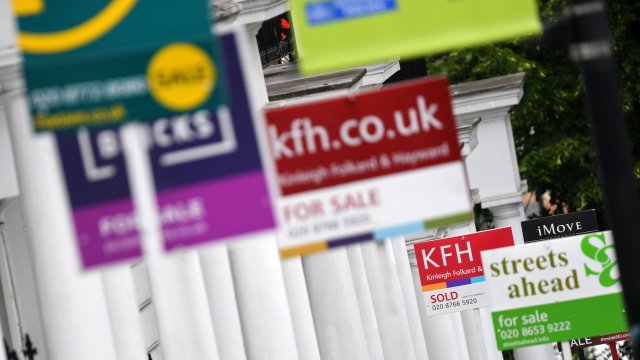Housing demand is reaching its seasonal peak amid some promising signs for the spring homebuying market.
According to the National Association of Realtors, existing home sales were up 9.5% month over month in February and prices were up 5.7% year over year, marking a strong start to the 2024 housing market. Inventory was also up in February 2024 to 2.9 months from 2.6 months the year prior, so there’s hope that this year might be less frustrating for homebuyers, despite stubbornly high interest rates.
The Federal Reserve announced that its rate hike program may soon end, as mortgage interest rates fell at the end of March for the second consecutive week.
What can you expect for the busiest time of year for the real estate market? Probably a heady mix of drama and frustration, as both buyers and sellers take advantage of warmer weather and longer days to scour local markets for their next homes. Here are the top things to keep in mind as you’re shopping for your new home.
1. Affordable Homes Are Still Out There, But It’s Competitive
Affordability is on everybody’s mind, with mortgage interest rates still hovering around 7% and the median home sales price at $384,500, a 5.7% increase year over year. There’s a very real question about just how much further buyers can bend before they break. Experts say that affordable homes are out there, but in many markets you may face stiff competition.
“Expect continuing multiple offers on affordable homes,” says Lawrence Yun, chief economist and senior vice president of research at the National Association of Realtors. “Job additions are creating more housing demand, but the supply of affordably priced homes is still limited.”
If your job is mobile, or you work fully remote, you may find it much easier and more affordable to buy outside your current market.
“The relative abundance of options in the South should make that area a bit easier to buy in than in previous years,” says Danielle Hale, chief economist at Realtor.com. “While the Northeast and Midwest offer relative affordability of homes, that feature has been drawing buyers in and keeping these markets relatively competitive.”
According to Realtor.com research, nationally, the supply of homes priced between $200,000 and $350,000 increased 20.6% year-over-year in February 2024, versus a 14.8% increase in overall housing inventory for sale. The markets with the most relatively affordable homes for sale include Orlando, Miami and Tampa, but there’s been a significant increase in these homes across the South, Midwest and Texas.
2. New Construction Is a Viable Option for All Buyers
With new construction homes coming in at a median sales price of $400,500 for February, according to the U.S. Census Bureau, the cost to buy new is only a little more than 4% higher than an existing home.
“With more inventory available, the ability to buy down mortgage rates and attractive incentives such as free refinancing within three years of purchase, new construction homes are becoming increasingly appealing,” says Brandon Lwowski, senior director of research at HouseCanary, an AI-powered residential real estate data and analytics firm based in San Antonio. “As existing home inventory remains tight, it’s expected that more future homeowners will gravitate towards the new construction market.”
Sales of new construction homes are up, but don’t let that deter you. An increase in builder confidence means more new homes will be ready to go sooner rather than later.
“Some reports say that nearly 32% of homes sold last quarter were new construction,” says Amy Lessinger, president at RE/Max in Denver. “The Commerce Department also said, ahead of what tends to be a busy season for the market, that new-home construction soared in February. Overall, an increase in new construction and growing builder confidence is indicative of more options for buyers this year.”
According to Yun, one-third of current listings are new homes right now. Usually, it’s closer to 10%, so you may find yourself in a new home this spring.
3. Despite Rate Lock-Ins, Life Changes Push Sales
Even if you’re already in the market and it feels bleak, keep in mind that life is continually happening to homeowners. Circumstances they might not have expected are turning them into home sellers, even if they’ve been trying to stay on the sidelines.
“Some homeowners who have delayed listing in the past couple of years, despite life-changing circumstances, can no longer delay,” says Yun. “There were 7 million newborn babies over the past two years whose parents may need to list their starter home and trade up. There were 7 million people who hit the retirement age of 65 who may want to trade down. Marriage and divorce lead to more listings. There were also around 50 million job switches, which means different commuting patterns that may require a different residence. Expect more supply.”
With this increased supply from homeowners who absolutely must sell, there’s another unexpected benefit: the potential to assume their mortgages. An assumption allows you to essentially take over the seller’s mortgage – and their interest rate. This won’t be possible on all properties, but it’s certainly a bonus to watch out for.
“Homebuyers who are looking for ways to maximize their housing budget and are willing to put in some effort to secure a loan may consider whether an assumable mortgage is something to look for,” says Hale. “A recent Realtor.com analysis showed that in markets where they are most common, sellers advertise assumable mortgages on 1% to 3% of homes for sale.”
Mortgage assumption can be one way for buyers to save money while interest rates are high, and it can help sellers stand apart from the competition by offering a more affordable home loan.
4. Remember the Seller Is Still Leading Negotiations
With only 2.9 months of inventory currently available, remember that it’s still a seller’s market. That means that no matter how badly you want a particular home, no matter how much you think your local market has cooled, the seller can easily walk away from your offer because they know another will be along any moment.
“In some competitive markets, buyers should be proactive in making their offer stand out,” says Lessinger. “Rather than starting with a low bid, it’s essential to present a strong initial offer to avoid losing out. Sellers often prioritize offers with fewer contingencies and more flexible terms, such as accommodating the seller’s preferred move-in date.”
She also stresses the importance of having a trusted buyer’s agent in your negotiations. They can advise you on how to craft the most effective offer for your financial goals, and advocate on your behalf in a multiple offer situation.
A Regional Breakdown
Among the four major U.S. regions, monthly sales in February jumped in the West, South and Midwest, and were unchanged in the Northeast. Year-over-year, sales declined in all regions. Here’s a look at each market.
Northeast: At 480,000 units, existing home sales in the Northeast were identical to January but down 7.7% from February 2023. It wasthe fourth consecutive month that home sales in the Northeast registered 480,000 units. The median price in the Northeast was $420,600, up 11.5% from one year ago.
Midwest: In the Midwest, existing home sales jumped 8.4% from January to an annual rate of 1.03 million in February, down 3.7% from the previous year. The median price in the Midwest was $277,600, up 6.8% from February 2023.
South: Existing home sales in the South leapt 9.8% from January to an annual rate of 2.02 million in February, down 2.9% from one year earlier. The median price in the South was $354,200, up 4.1% from last year.
West: In the West, existing home sales skyrocketed 16.4% from a month ago to an annual rate of 850,000 in February, a decline of 1.2% from 2023. The median price in the West was $593,000, up 9.1% from February 2023.
Compare Top Mortgage Lenders
|
|||||
|
|||||
|
Whether you’re looking for access to the Washington, D.C., metro area or are seeking peace and quiet in the suburbs, Maryland is a great state to call home. The average home value in Maryland is about $406,843, according to Zillow, a 3.6% increase from a year ago.
The Baltimore/Columbia/Towson area ranked No. 46 on Realtor.com’s 2024 forecast of the 100 largest housing markets. Baltimore’s median home price falls at the lower end ($177,786), with Columbia at the high end ($479,909), with Townson falling in the middle at there is440,118, up about 4% from a year ago, according to Zillow. While the greater Washington, D.C. area came in at No. 44, homes in Montgomery County, bordering Washington D.C., are the most expensive in the state, according to data collected by statewide association Maryland Realtors. Homes in Montgomery County range from a median home price of $526,417 in Silver Spring to more than $1 million in Bethesda, according to Zillow.
Meanwhile, Hagerstown, on the border of Pennsylvania, has a more modest median home price of $263,890, and Havre de Grace, on the opposite side of the state, at the mouth of the Susquehanna River and the head of Chesapeake Bay, has a median home price of $377,898.
No matter which area of Maryland you’re looking to move to, it’s important to find the right real estate agent to help with your home search. Here are some of the top real estate companies in Maryland, by sales volume according to RealTrends agent ranking service.
The Bob Lucido Team of Keller Williams Lucido Agency employs more than 100 agents. Based in Ellicott City, the firm earned $991 million in sales in 2023. Bob Lucido’s real estate career stems back to 1976, when at age 18, he became one of the youngest people to obtain a real estate license in Maryland. In 2008, he and his wife, Tracy, founded the Bob Lucido Team in Howard County. In 2016, the team expanded and launched Lucido Agency, its global real estate division.
Nurit Coombe and Alex Martinez lead a team of more than 30 agents plus support staff operating out of North Bethesda. Affiliated with luxury brand The Agency, the team services areas including Bethesda, North Bethesda, Potomac and Kensington. Team Nurit & Alex earned more than $326 million in sales in 2023. Coombe and Martinez are also the hosts of “The American Dream,” a national cable talk show highlighting the Washington D.C. area’s culture, lifestyle and best real estate listings.
The Bob & Ronna Group of Berkshire Hathaway HomeServices PenFed Realty has offices in Annapolis, Baltimore, Bethesda, Bel Air, Columbia, Ellicott City, Frederick, Monkton, Rockville, Severna Park and Towson. The team consists of nearly 80 real estate agents, plus a management and support team. The Bob & Ronna Group works with buyers in the market for luxury homes, single-family homes, condos and townhomes. In 2023, the firm earned $290 million in sales.
The Maryland & Delaware Group of Long & Foster is team of more than 30 agents responsible for over $228 million in real estate transactions. Operating out of its office in Salisbury, the team also serves Berlin, Delmar, Fruitland, Pittsville, Ocean City, St. Michaels, Ocean Pines and Princess Anne. The agency aims to provide real estate customers everything they need in one place, from a wide variety of properties and personalized financing services, to moving and repair services.
Raised on the waters of the Chesapeake Bay, Brad Kappel is a third-generation Annapolitan and executive vice president of TTR Sotheby’s International Realty. Kappel offers an insider understanding of the unique differences in each of the area’s waterfront communities. His background in home construction and renovation provides practical insight into a property’s current condition and potential. With a support staff of three, including his wife, Barb, Kappel earned $209 million in sales in 2023.
A native Washingtonian, Nathan Dart leads a team of 10 based in Bethesda. Affiliated with Long & Foster Real Estate, Dart Homes serves Poolesville, Gaithersburg, Germantown, North Potomac and several other neighborhoods in Montgomery County. In 2023, the team earned $189 million in sales.
From first-time homebuyers to experienced investors, SURE Group of Berkshire Hathaway HomeServices Homesale Realty works with a range of clients in the Greater Baltimore area. Neighborhoods serviced include Charles Village, Locust Point, Fells Point and Brewers Hill. Led by owners Andrew Undem and Matthew Pecker, the team of nearly 20 earned $188 million in sales in 2023.
Based in Bethesda, Barak Sky leads The Sky Group of Long & Foster Real Estate. With a team and support staff of more than a dozen professionals, the Sky Group works with clients looking to buy in areas ranging from Bethesda to Potomac to Chevy Chase, as well as Washington, D.C. and Virginia. In 2023, The Sky Group earned more than $187 million in sales.
Led by Nick Waldner, the Waldner Winters Team of Keller Williams Realty Centre consists of 20 agents and an administrative and support staff of nine. Waldner himself specializes in waterfront properties and has hosted TV shows including TLC’s “My First Home” and FYI’s “Waterfront House Hunting.” Based in Columbia, the Waldner Winters Team serves areas including Baltimore, Bel Air, Westminster, Rockville, White Marsh and Annapolis. The firm earned $169 million in sales in 2023.
The Banner Team has specialized in luxury and upper bracket properties throughout Bethesda and Potomac in Montgomery County, Maryland and the metropolitan D.C. region for over 35 years. Its 12 real estate agents assist buyers looking to purchase or custom build a new home as well as sellers. Based in Bethesda and affiliated with Long & Foster Real Estate, the team earned $159 million in sales in 2023.
How to Find a Real Estate Agent Near You
Your search for a real estate agent might start with one of the companies above. All have great knowledge and experience in the Maryland real estate market.
Before you choose your real estate agent, talk to several professionals and ask questions to get a sense of how they operate. If you know people who recently bought homes in Maryland, ask who they used and whether they’d recommend their agents. The more research you do, the more likely you are to end up with a real estate agent you’re happy with.
Compare Top Mortgage Lenders
|
|||||
|
|||||
|
By Mary Mrad For Daily Mail Australia
02:05 23 Mar 2024, updated 02:05 23 Mar 2024
Share or comment on this article:
Adrian ‘Mr. Lambo’ Portelli has announced a new auction date for Eliza and Liberty’s The Block property.
The high-profile entrepreneur snapped by the home for $4.3million during the finale last November.
Portelli revealed on his Instagram story on Saturday, that the property’s auction has been rescheduled to April 7.
‘The Block auction that was meant to be tomorrow is no longer tomorrow because it’s the biggest weekend in Melbourne,’ he said referring to the Australian Grand Prix.
‘So we did postpone it and it will now be Sunday 7th April. Tomorrow it is no longer going ahead.’

The gorgeous five-bedroom, four-bathroom home in Melbourne‘s Hampton East has been listed with a price guide of $2,900,000 – $3,200,000.
Located 17kms from the CBD, the original classic brick mid-20th century home was spectacularly redone by Eliza and Liberty Paschke last year.
Eliza, 37 and 34-year-old Liberty, who have no renovation experience, walked away with $1.05million after the sale.
Featuring a sleek US modern feel in its design, the spacious home boasts Woodec double glaze windows – perfect to protect owners from Melbourne’s chilly winters.
Highlights include a pool, a large undercover entertainment deck and sculptured garden.
There’s also two ‘zoned’ living spaces, including a media lounge, a home office and a ‘guest suite’ perfect for Airbnb use.
Other finishings include oak floors and brass pendant light fittings and other highlights are a huge kitchen with breakfast bench.
READ MORE: Baby love! Shirtless Adrian ‘Mr Lambo’ Portelli flaunts his tattooed torso on his first holiday away with his partner and newborn son on Gold Coast holiday
Hot tech industries and diverse economies are fueling housing demand in Texas, home to the nation’s fastest growing housing markets in 2024, according to a forecast by the National Association of Realtors. Austin and Dallas-Fort Worth are expected to be the nation’s top two markets based on demand, while Houston ranked sixth.
The average home value in Texas is about $298,624, reports Zillow. That’s about a 0.1% decrease from a year ago. But home prices can vary substantially from one metro area within the state to another.
The median home price in Houston, for example, is $264,626. The median home price in the Dallas-Fort Worth area is $307,990. And in Austin, the median home price is even higher at $4,533,719. It’s a different story in the northern part of the state, however: Amarillo’s median home price is just $194,790.
Robust population and job growth are fueling new construction in Texas’ top three metro areas. While prices in the cities are expected to remain steady, smaller towns like Lamesa and Dumas in northwest Texas might see price corrections, according to the Houston Association of Realtors.
The combination of warmer weather and no state income tax could make Texas an ideal spot to plant roots, whether you’re still working or are looking for a place to retire.
No matter where you decide to settle down in Texas, it’s important to find the right real estate company to help with your home search. Here is a list of the top real estate firms in Texas by sales volume, according to RealTrends agent ranking service.
Having worked with more than 60 homebuilders in Dallas-Fort Worth, Houston, Austin and San Antonio, Ben Caballero, founder and CEO of HomesUSA.com, is a known for being one of the most productive real estate agents in the world. Three times, Cabellero was awarded the Guinness World Records title as selling the highest number of homes in the world – his most recent recognized year being 2020, when he sold 6,438 homes. A former homebuilder, Caballero hosts the podcast series “Lessons from the #1 ranked Real Estate Agent in the World.” He earned more $3 billion in sales in 2023, with his online platform assisting homebuyers looking for homes in the major metropolitan areas as well as Abilene, Texas.
The Loken Group, a team of specialists out of the Keller Williams Platinum office, works with homebuyers in all nine counties in the greater Houston area. The Loken Group was ranked by RealTrends as the No. 1 Large Team in Houston in 2023 based on volume, with $756 million in sales. The team is comprised of over 30 specialists and operates out of Houston.
After a successful start with RE/MAX in 2012, Levi Rodgers formed the the Levi Rodgers Real Estate Group in 2016 and spun off from RE/MAX in 2020. Based in San Antonio, the Levi Rodgers Real Estate Group also offers service coverage locally in Austin and Killeen. The firm has grown to 250 licensed agents and earned $732 million in sales in 2023.
The Heyl Group at Keller Williams has more than 10 years of experience and has worked with more than 7,000 customers in central Texas. Based in Austin, the team focuses on neighborhoods including Cedar Creek, Lakeway, Manor, Elgin and Cedar Park. The Heyl Group earned $607 million in sales in 2023.
The Franklin Team, which is affiliated with eXp Realty, closed roughly 1,400 homes totaling over $593 million in sales in 2023. Based in Katy, the team of nearly 50 professionals serves buyers in communities ranging from Magnolia to Sugar Land to Deer Park and many more.
The Rhodes Team is a North Texas real estate firm serving areas including Plano, Allen, Highland Village and McKinney. Based in Flower Mound, the team consists of more than 40 professionals who closed $591 million in sales in 2023. The Rhodes Team is affiliated with Berkshire Hathaway HomeServices and Penfed Realty Texas.
The
The Matthews Team, which is affiliated with RE/MAX, has over 25 years of real estate experience. The team of 13 works out of Spring, and its founders have been deeply entrenched in the real estate market since the late 1980s. In 2023, the team earned $390 million in sales.
With more than two decades of experience, Mark Dimas leads a staff of 27 serving the greater Houston area. Based in Cypress, the firm helps clients buy and sell homes in Sugar Land, Galveston and Pearland, among many other neighborhoods in the Houston area. In addition to homebuying and selling, the team also provides property management services for landlords. In 2023, Mark Dimas Team earned $320 million in sales.
Based in Dallas, Alex Perry earned $303 million in sales in 2023. With more than a decade of affiliation with Allie Beth Allman & Associates, Perry is experienced in high-end home sales, representing both sellers and buyers. He specializes in the Park Cities, Preston Hollow and surrounding neighborhoods.
Detwiler + Wood Group, a team affiliated with Compass Real Estate, achieved over $300 million in sales for 2023. Detwiler + Wood Group has operated in the Dallas-Fort Worth area since January 2018. The team consists of nine agents and operates out of Dallas.
How to Find a Real Estate Agent Near You
Ultimately, you’ll want someone who not only knows the area inside and out, but who also listens to what you’re looking for, is mindful of your budget, and is generally communicative and easy to work with.
Compare Top Mortgage Lenders
|
|||||
|
|||||
|
For decades, Florida has drawn retirees attracted to its absent income tax. More recently, it has become a hot spot for remote workers seeking affordable housing, at least compared to the Northeast and West.
The trade association Florida Realtors says rising inventory, albeit still well below demand, is returning prices to prepandemic rates of growth. The average Florida home value is around $388,454, according to Zillow, an increase of just 2.5% from a year ago, though up 18% since January 2022 and up 59% since January 2020, when the average home was worth $244,021.
Polk county, southwest of Orlando, is the fastest-growing county in Florida and seventh-fastest in the nation, according to an analysis of U.S. Census data by the Tampa Bay Times. In addition to Polk, population growth has been concentrated in the counties of Orange (home to Orlando), Hillsborough county (Tampa), Lee (Fort Myers) and Palm Beach.
Home prices can fluctuate a lot depending on which part of the state you opt to live in.
The median home price in the Miami-Fort Lauderdale-West Palm Beach area is $477,917. In Orlando, the median home price is $379,953, and in Tampa, it’s $375,241, and in the capital city of Tallahassee, it’s $280,791, according to Zillow.
But no matter which part of Florida you’re looking to move to, it’s important to find the best real estate company to aid in your home search. Here are some of the top real estate firms in Florida by sales volume, according to RealTrends agent ranking service.
Based in Orlando, Jay Kendall earned $2.1 billion in sales in 2023. Kendall became a realtor after moving with his wife to Orlando in 2012. He served in the U.S. Army and Army Reserve for a combined 21 years, retiring in August 2013, having served in Kuwait, Iraq and Afghanistan. A U.S. Military on the Move certified specialist, Kendall says he understands firsthand the difficulties associated with relocating. He also has experience as a landlord and real estate investor. Kendall assists buyers and sellers along the East Coast and Central Florida, including St. Augustine, Amelia Island, the Space Coast and Treasure Coast.
Robert Slack LLC was founded in October 2014 with four agents in Ocala, buying leads from Zillow. That year, it closed 54 transactions. In 2023, the firm locked in $1.9 billion in sales. The firm now has more than 600 agents and services the entire state of Florida. Its website also features episodes of its own TV show “Selling Florida,” which highlights the best communities, small businesses, local hang outs and real estate in Florida.
The Jills Zeder Group brings three families and two generations’ worth of experience to the table for South Florida homebuyers. The firm specializes in luxury Florida real estate, closing $1.6 billion in sales in 2023. Its 14 real estate agents’ focus now spans from Golden Beach to Pinecrest. The Jills Zeder Team is closely affiliated with Coldwell Banker, and as such, expands its reach to international buyers across 43 countries and territories. The company maintains two offices in Florida – one in Coral Gables and one in Miami Beach.
Based in Boynton Beach, Ralph Harvey has more than 17 years of experience in the real estate industry. In 2023, he earned nearly $1 billion in sales. As a broker and CEO/president of List With Freedom, he heads an online platform that enables homeowners to list their home directly on the multiple listing service (MLS) database, charging a one-time flat fee, with an optional additional fee for the buyer’s agent. Operating since 2005, List With Freedom has a customer support staff of four to help sellers interested in having control of their home selling process.
Founded in 2006, Christian Angle Real Estate specializes in luxury oceanfront estates or condos, residential homes and commercial properties in Palm Beach and South Florida. The firm is comprised of President/Broker Christian Angle and his wife, Ann-Britt, who serves as director of operations. Angle earned $790 million in sales in 2023.
Based in St. Augustine, DJ & Lindsey Real Estate employs more than 70 agents serving clients in Jacksonville, Ponte Vedra, St. Augustine and Palm Coast. The firm recorded more than $659 million in sales in 2023. It’s also the official real estate team for the Jacksonville Jaguars.
With more than two decades of experience, Chad Carroll leads a team of more than 40 real estate agents who focus on the luxury market. The Carroll Group made $628 million in sales in 2023. It is affiliated with Compass, a major real estate firm, and has offices in Miami Beach, Aventura, Fort Lauderdale, Boca Raton and Palm Beach.
Douglas Elliman’s Teixeira Team employs nine brokers and sales associates based in Fort Lauterdale. Daniel Teixeira, vice president of business development at Douglas Elliman Development Marketing, leads the team, which is focused on luxury residences and condominiums in south Florida. He has more than 25 years of real estate experience and has sold more than $2 billion in premier waterfront properties and high-rise developments. In 2023, the Teixeira Team earned $537 million in sales.
Christopher Leavitt and Ashley McIntosh lead a team of seven licensed real estate agents based in Palm Beach. Currently the executive director of luxury sales at Douglas Elliman, Leavitt has more than 25 years of real estate experience. McIntosh has been a Palm Beach resident for 36 years and real estate agent for 34, having made her start selling luxury properties at Palm Beach Polo and Country Club. The Leavitt McIntosh Team earned $493 million in sales in 2023.
ölkers 30A Beaches
Focused on 30A, a stretch of coastline located in the Florida panhandle, Blankenship Group helps buyers find homes or condos in neighborhoods like Inlet Beach, Rosemary Beach, Seacrest, Alys Beach, Watersound Beach, Watercolor and Santa Rosa Beach. The team of 12 is led by Beau Blankenship, a luxury real estate advisor and investor who opened his first brokerage in 2018 at the age of 27. The company’s affiliation with Engel & Völkers also allows it to assist buyers interested in south Florida cities like Miami Beach, Fort Lauderdale and Palm Beach. Blankenship Group earned $433 million in sales in 2023.
How to Find a Real Estate Agent Near You
It’s important to find a real estate agent you can work with seamlessly – someone who communicates steadily and is respectful of your budget. It pays to interview agents from multiple real estate companies to land on the right person to partner with for what could be the biggest purchase of your life.
Compare Top Mortgage Lenders
|
|||||
|
|||||
|
Homeowners could see a significant drop in the cost of selling their homes after a powerful real estate trade group agreed last week to resolve antitrust litigation accusing brokerages of inflating sales commissions.
The $418 million settlement calls for the Chicago-based National Association of Realtors (NAR) to eliminate decades-old rules on commissions, and make it easier for buyers to negotiate fees with their own agents or use no agents at all, Reuters reports. The accord resolves claims against more than 1 million members, state and local realtor associations, and most smaller brokerages.
The move could mean major shifts in how buyers and sellers pay their agents – and just how much those fees cost moving forward.
What’s In The Settlement?
The March 15 settlement comes after several years of litigation, including class-action suits from home sellers and a legal battle with the U.S. Justice Department. As part of the settlement, the realtor group agreed to prohibit offers to compensate the buyer’s agent on multiple listing services (MLS), a practice that critics say reduced price competition and led to inflated commissions and home prices.
NAR will also require buyer’s agents to enter written agreements with all clients, outlining their fees and services before moving forward with any work. According to experts, the settlement will usher in sweeping change for buyers, sellers and agents alike.
“It’s hard to predict the timing of actual changes to the real estate market, but it’s clear now that change is coming, and perhaps sooner than anyone thought possible,” says Steve Nicastro, a real estate agent and content lead at Clever Real Estate in Charleston, South Carolina. “This will likely lead to lower commissions overall, and a change in how homebuyers use and pay their agent.”
What Were the NAR Lawsuits About?
It’s a little complicated, but the basis of the recent NAR lawsuits boiled down to the group’s MLS cooperative compensation rule, which was introduced in the 1990s in response to calls from consumer protection advocates for buyer representation
According to that rule, in order to list a for-sale property on an MLS – the databases agents use to share properties amongst themselves – they must offer a commission to the agent who ultimately brings in the winning buyer. Historically, this has resulted in a 5% to 6% total commission, with half going to the seller’s agent and half to the buyer’s agent.
Here’s the catch, though: The buyer doesn’t pay their agent’s fee directly. Instead, the commission is fully paid by the seller as part of their closing costs. According to the recently settled suit, as well as other litigation, this amounts to a form of antitrust, allegedly reducing competition and pushing up commissions higher than services warrant.
While NAR agreed to settle the suits against it, the group has made it clear it denies any wrongdoing in connection with its MLS or compensation rules.
“NAR has worked hard for years to resolve this litigation in a manner that benefits our members and American consumers,” said Nykia Wright, interim CEO of NAR, in a statement. “Ultimately, continuing to litigate would have hurt members and their small businesses. While there could be no perfect outcome, this agreement is the best outcome we could achieve in the circumstances.”
What It Means for Buyers and Sellers
The rule changes, which are set to go into effect in mid-July, represent a major change to the way real estate agents have operated going back to the 1990s, and could lead to homebuyers and sellers negotiating lower agent commissions.
The settlement still needs court approval, but if that comes through, things could start to change in the real estate industry – and quickly. For one, buyers will need to start negotiating with their agents from the get-go.
“If the buyer’s agent fails to negotiate their commission with the seller, they will have to contract and arrange compensation to be paid by the buyer,” says Suzanne Seini, founder of Innovate Realty in Irvine, California. “This can strain first-time homebuyers who may be exercising their max budget to buy a home in the price point and area they desire.”
It could also have benefits, though, allowing buyers more freedom to pay for the services they want – and avoid paying for those they do themselves.
“Buyers will likely desire a more flexible structure now, as they can pick and choose which services they want from a buyer’s agent,” Nicastro says. “So, I think it will be more like a pay-for-service structure versus a 2.5 to 3% flat commission rate.”
Luke Babich, CEO of Clever Real Estate in St. Louis, expects buyers to have more of a “menu” of services once the new rules go into effect.
“You could pay a small fee for an agent to do an on-demand showing for you, or you could pay 0.5% to 1% if you just want help with negotiations – and maybe that’s all provided remotely,” Babich says. “You could pay 1.5% to 2% for an agent who will commit to a certain level of availability and take you to regular showings. We’ll see a wider range in pricing for different service levels.”
All in all, the changes will likely result in reduced commission costs across the board. Prior to the settlement, a report from consulting firm Keefe, Bruyette & Woods projected an “unbundling” of agent services could potentially reduce commissions as much as 2 percentage points or more. This week, economists told The New York Times it could mean about a 30% drop, which would take commissions from about 3% per agent down to around 2% or less.
These are just initial predictions, though. It’s likely that fees and services will evolve gradually over time as the industry, agents and consumers adjust to the new normal.
Compare Top Mortgage Lenders
|
|||||
|
|||||
|
The average price of a newly marketed home jumped by more than £5,000 month-on-month in March, in signs that “we now seem to be past the bottom of the market,” according to a property website.
House sellers lifted their asking prices by the largest amount in 10 months in March, new data from Rightmove shows, as buyer demand increased in the busier spring selling season.
Across the UK, typical home prices have grown 1.5 per cent or £5,279, Rightmove said. The average asking price is now £368,118. Rightmove said average prices remain £4,776 below last May’s peak.
With buyer demand up 8 per cent compared to the same period last year, the property website said it was a sign “we now seem to be past the bottom of the market”. Other house price surveys have also seen evidence of a market revival.
Tim Bannister, Rightmove’s director of property science, said: “March is typically a strong month for asking price growth, as both buyer and seller activity levels rise and the spring selling season gets under way.
“However, the stronger-than-usual price growth this March indicates that new sellers are feeling much more confident, with some perhaps being overoptimistic, that there is enough buyer activity and affordability in their local market to achieve a higher price.
“Despite the above-average price increases in this opening three months of the year, asking prices are still £4,776 below their peak in May 2023. For those who can afford to buy and have yet to take action to move this year, this may provide a window of opportunity to buy as we now seem to be past the bottom of the market.
“While some sellers are still being over-optimistic with their pricing expectations, there are also more sellers who are aware of the need to be negotiable and realistic, with elevated interest rates compared to recent years still stretching affordability for many buyers.”
The East Midlands had one of the biggest jumps monthly in asking prices – up 2.7 per cent. The average property price stands at £247,054 in the region. The South West of England follows with a 2.4 per cent monthly rise, taking the average asking price to £383,889.
The average time to find a buyer is now 71 days, which is the longest at this time of year since 2019, the website said.
“Sellers are right to feel more confident and optimistic this year, but buyer affordability remains stretched and higher mortgage rates are an ongoing challenge. With the market still sensitive to pricing and external events, some caution and willingness to negotiate is advised for sellers who are keen to find a buyer in the spring market,” Tim Bannister added.
The Rightmove figures come as a report warned that mortgage deals are often on offer for just 15 days before being pulled from the market, despite homeowners and buyers having the widest choice for 16 years.
This is the shortest shelf-life in six months, according to financial information service Moneyfacts.
Nathan Emerson, of estate agents group Propertymark, said: “Following three years of economic turmoil, Propertymark is hopeful we are now witnessing a positive trend towards increased prosperity in the housing market. For months, people have taken a hit on their property prices in order to find an affordable middle ground to enable a home move.
“Now that balance is being better struck and with interest rates remaining stable, we are seeing signs of normality and strong overall indicators now is an attractive time to buy or sell property.
“Our member agents have reported an 80 per cent increase in the number of new properties available and a 129 per cent increase in the number of market appraisals undertaken, showing there is growing appetite amongst buyers and sellers alike.”
The figures were released as a lettings index from property firm Hamptons indicated that growth in rental prices cooled in February.
Last month, the average rent on a newly-let home in Britain rose by 7.1 per cent annually, slowing from 8.3 per cent in January and a peak of 12.0 per cent in August 2023.
Real estate agents across the country have been thrown into confusion by the National Association of Realtors’ settlement of a series of lawsuits over commissions.
While plaintiffs and consumer advocates hailed Friday’s settlement as a big win that could lower the costs of buying a home, agents are expressing fear and frustration. They’re worried about their futures and warn that home buyers could wind up getting hurt, deprived of valuable advice.
“The knee-jerk reaction is concern,” says Dana Bull, a Boston-area real estate agent. “For real estate agents, their livelihood feels threatened.”
Home sellers traditionally pay broker commissions to their listing agent as well as the buyer’s agent, which then get split 50-50 by both agencies. Commissions are negotiable and can start as low as 2% or 3%, but they often range between 5% and 6%.
The lawsuits claimed that these practices helped inflate commissions. While the NAR denied wrongdoing, it instituted several changes for its over one million members. Sellers can no longer advertise the amount they’re willing to pay a broker’s agent through NARs’ regional databases; and buyers now need to sign agreements with their agents directly, and negotiate that fee upfront.
Many advocates have said the changes may lower broker commissions. Anthony Lamacchia, a Massachusetts-based Realtor who has spoken publicly in defense of NAR, doesn’t think they will. Having to negotiate commissions may push many agents out of the business, particularly part-time agents or those that fail to keep up with the skills required by a more competitive ecosystem — and the stronger agents are likely to keep their fees about the same, he adds.
Advertisement – Scroll to Continue
But that could be a silver lining, some agents say, for both consumers and agents. By negotiating commissions directly with buyers, agents and firms will have to become better at differentiating themselves from others to succeed in the business, says Michael Downer, a Realtor with Coldwell Banker Realty based in Naples, Florida.
“This is the best thing that’s ever happened to professional real estate agents,” Downer added.
The settlement comes as real estate brokers are facing a challenging market after the 2020 boom. In 2023, there were fewer than three homes sold per NAR member, the lowest per capita since at least 1981.
Advertisement – Scroll to Continue
Some agents fret that the changes from the settlement could have unintended negative consequences on buyers, especially those that are more cash-strapped. Those buyers may opt for low-service discount brokers, or forgo representation altogether if they are forced to pay their broker fee out of pocket.
“It’s really scary, and I think it’s hurtful because I feel like I provide a valuable service to clients,” says Chandra Ashford, a Portland, Oregon, real estate broker.
Ashford works primarily on the buyer side of the equation. Most of her clients are first-time home buyers who she’s helped guide through the process of closing on a house. Her firm, the Portland House Hunters, recently started brokering direct agreements with buyers, to varying degrees of success. Many potential clients have said they don’t want to be on the hook for the fee, she added.
Advertisement – Scroll to Continue
Without representation of their own, buyers may be forced to rely on the seller’s broker alone, which could end up hurting both buyers and sellers, says Valerie Falkner, a Phoenix, Arizona, based Realtor.
“The seller is getting less representation, the buyer is getting some representation, but now we’re sort of working for both sides,” Faulkner says. That makes it hard for either side to drive a fair negotiation, she added.
Perhaps the overwhelming sensation for agents in the wake of the decision is a sense of uncertainty as many questions remain unanswered. These include macro-level questions, such as whether this decision will actually help lower home prices, as well as industry-specific queries, such as whether it will fuel the rise of new real estate models.
Advertisement – Scroll to Continue
“I think it’s going to get sloppy,” Bull, the Boston-based agent, says. “It is going to create confusion, at least for the next couple of market cycles as people figure it out.”
Corrections & Amplifications
Anthony Lamacchia doesn’t believe the changes will drive commissions lower. A previous version of this article incorrectly stated he did.
Write to Sabrina Escobar at sabrina.escobar@barrons.com
For the fifth month in a row, home prices in the U.K. have increased from the previous month, with prices up 0.4% in February, according to Halifax’s House Price Index, released on Thursday.
Additionally, prices were up from the same time last year, increasing 1.7% to £291,699 (US$374,779)—which is about £1,000 higher than January.
“Yet further proof that the property market is back on track with a fifth consecutive monthly increase demonstrating that real momentum is now starting to build,” said Marc von Grundherr, director of Benham and Reeves.
MORE: More Affluent Home Sellers Are Turning to Auctions. That’s Great News for Buyers.
The U.K.’s housing market suffered last year amid rising interest rates, but the market has continued to show signs of bouncing back since the increases were halted.
Advertisement – Scroll to Continue
“U.K. home buyers have welcomed the increased degree of market stability that has come following the decision to hold interest rates at 5.25% since September of last year, and as home buyers have returned to the market, we’ve seen declining house prices start to reverse,” said Guy Gittins, CEO of Foxtons.
Property prices increased the most in Northern Ireland, which saw an annual increase of 5%, bringing the average home price to £195,956, according to the report.
London, which maintains the U.K.’s highest average house price, had prices increase 1.5% on a yearly basis—the city’s first positive annual growth since January 2023—to an average of £536,996.
“The higher cost of borrowing does, of course, remain an obstacle for many buyers, but with a potential rate cut on the horizon, we expect market conditions to continue to improve as the year progresses,” said Jason Harris-Cohen, CEO of Open Property Group.
New York is an extremely diverse state in terms of income, lifestyle and property values. The average median home in New York state is $450,431, up 4.9% year over year, with a median of 38 days to pending, according to Zillow. That encompasses a wide swath of real estate: In New York City, home values now average around $727,695, while in Kings County, New York, on the southwestern tip of Long Island, the median home price is $814,963, down 1% year over year; and in the capital city of Albany, the median home is $280,732, 6.6% year over year.
New York City itself is a draw for many people who want access to amenities like nightlife, public transportation and nearby jobs. With only 10% of homes there sold over asking price and 48% sold under asking price, Rocket mortgages has deemed New York City a buyer’s market in February 2024.
But whether you’re looking to live in New York City proper or elsewhere in the state, it’s essential to find the right real estate company to help you with your home search. Here are the top real estate firms serving New York:
Founded by Oren and Tal Alexander, the Alexander Team provides white-glove service for buyers and sellers interested in newly developed luxury homes. The Alexander Team earned $1.3 billion in sales in 2023. In partnership with real estate broker Official, 12 of its licensed real estate agents service New York City neighborhoods including Lower Manhattan, Upper West Side, Upper East Side, Tribeca, Chelsea and Gramercy.
Specializing in Manhattan, Brooklyn and the Hamptons, the Hudson Advisory Team offers a comprehensive range of services including sales, rentals and new development marketing. Founders Clayton Orrigo and Stephen Ferrara lead the team of more than 30 licensed real estate professionals who pulled in more than $935 million in sales in 2023. The firm also has partners across the country, including South Florida, Aspen, Colorado, Los Angeles and San Francisco.
A broker at Stribling & Associates for over 25 years before it was purchased by Compass, Alexa sells some of the highest-end properties in Manhattan, but her reach includes customers and properties in varied price ranges. Compass Real Estate has 16 officesin New York City, 19 offices in Westchester and Hudson Valley, six in The Hamptons and 12 on Long Island.
Shaun Osher founded CORE in 2005. The company employs approximately 40 licensed real estate agents who specialize in 23 neighborhoods within New York City. As CEO, he has been responsible for more than 30 projects and $6 billion in sales. A native of Johannesburg, South Africa, Osher graduated from The New School and began his career in 1994.
With over $5 billion of luxury co-op, condo and townhouse sales, Cathy Franklin is a 30-year real estate veteran who has consistently ranked among Corcoran’s top real estate agents. Franklin recorded over $600 million in sales volume in 2023.
Corcoran is committed to serving its original markets in New York City, the Hamptons and South Florida, but the company is expanding to new markets across the country.
Hedgerow Exclusive Properties is a real estate and marketing firm with 17 licensed real estate agents. Operating from Bridgehampton, New York, it had a sales volume in excess of $500 million in 2023.
A native of Shanghai, Carrie Chiang was raised in Hong Kong and spent time in Brazil before moving to New York in 1988. In addition to her experience trading the city’s prestigious condominiums, Chiang has sold more than 100 townhouses and more than $10 billion in real estate. She brokered a $100 million deal with a Hong Kong-based consortium that enabled the construction of the Riverside Boulevard community on Manhattan’s Upper West Side.
Before she began her career in real estate, Serena Boardman was employed at Sotheby’s Auction House and then at LuxuryFinder.com. She started with Sotheby’s International Realty in 2001. Since then, she has sold in excess of $4 billion dollars of property. Boardman works in the co-op, condominium and townhouse markets both on the Upper East Side, Upper West Side and Downtown, focusing on the sale of top-tier properties, but also working with a variety of price ranges. The majority of Boardman’s sales are in the $5 million to $15 million range. Sotheby’s services 81 countries and territories and operates 1,000 offices worldwide, eight of them in New York.
Founded by Ari Harkov and Warner Lewis, The Harkov Lewis Team has a staff of 19 with 13 licensed real estate agents. The firm focuses on Manhattan’s luxury market and sold more than $400 million in 2023, according to RealTrends. Affiliated with Brown Harris Stevens, the team focuses on the Manhattan and Brooklyn real estate markets.
As managing director of the Lesser Team, Matthew Lesser has led his team to be townhouse experts within Leslie J. Garfield & Co. The Lesser Team covers Manhattan and Brooklyn, having expanded into Brooklyn nearly 10 years ago with partner Ravi Kantha, who joined Serhant Real Estate in 2024 with other members of the Lesser Kantha team. The Lesser Team sold more than $400 million in 2023, according to RealTrends.
How to Find a Real Estate Agent Near You
Whether you’re looking for a home in New York City or another part of the state, it’s essential to find the right real estate agent. You may want to search for a real estate agent with one of the companies above, or get recommendations from neighbors and friends. Teaming up with the right agent is an important step in the homebuying process, so take the time to ask the right questions and weigh your choices.
Compare Top Mortgage Lenders
|
|||||
|
|||||
|










